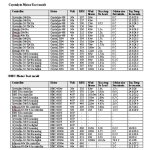oatnet
1 MW
Muad'dib, I thanked you on my build thread for that picture of the motor, but I'll thank you here again, great job! 
I count 32 magnets and 36 stator poles.
Great chart Steveo, thanks!
Wierd results. On the 36v20a controller, both the 36v/48v no-load rpm is significantly higher than the 72v35a controller - wait, how were they getting 48v on a 36v controller?
On the 72v35a controller, both 36 and 48v are at @451rpm, but the 48v sucks a lot more current and generates a lot more heat. Do you know if the 36v was analog and the 72v was digital, and maybe the 72v was bumping up against its electrical rpm limit? With 16 pole pairs and 5:1 ratio giving 80 electrical RPM, 451 wheel rpm is 36,080 electric rpm.
-JD
I count 32 magnets and 36 stator poles.
steveo said:I have someone that has tested this motor with a few different setups ... please check below..
Great chart Steveo, thanks!
Wierd results. On the 36v20a controller, both the 36v/48v no-load rpm is significantly higher than the 72v35a controller - wait, how were they getting 48v on a 36v controller?
On the 72v35a controller, both 36 and 48v are at @451rpm, but the 48v sucks a lot more current and generates a lot more heat. Do you know if the 36v was analog and the 72v was digital, and maybe the 72v was bumping up against its electrical rpm limit? With 16 pole pairs and 5:1 ratio giving 80 electrical RPM, 451 wheel rpm is 36,080 electric rpm.
-JD


